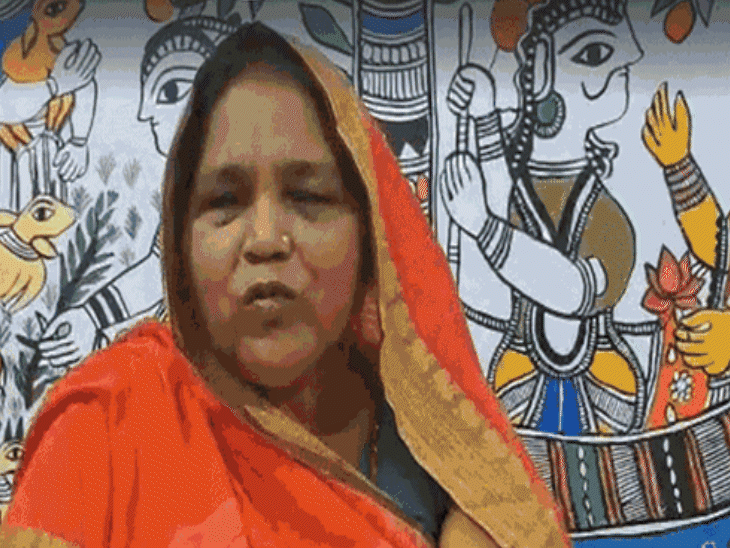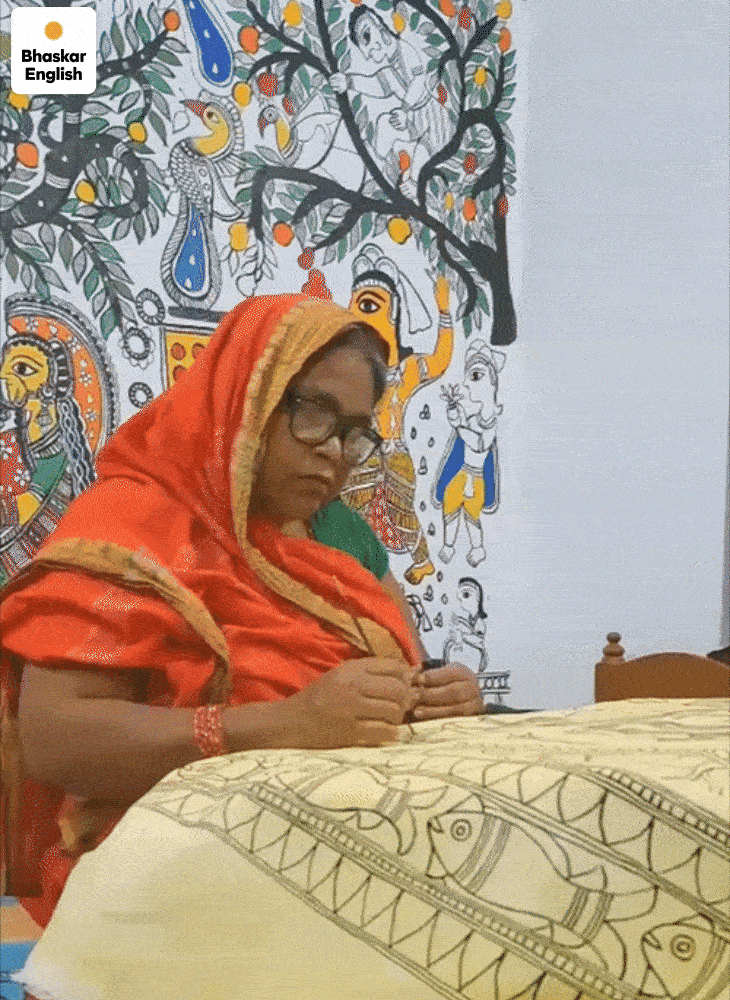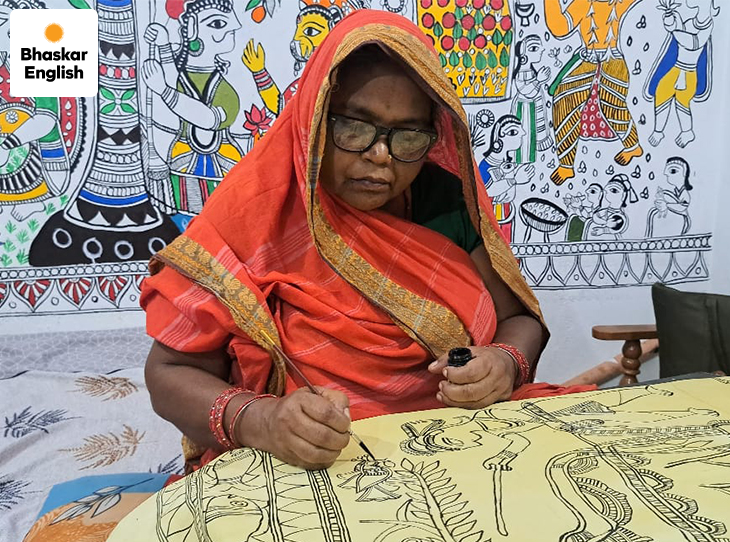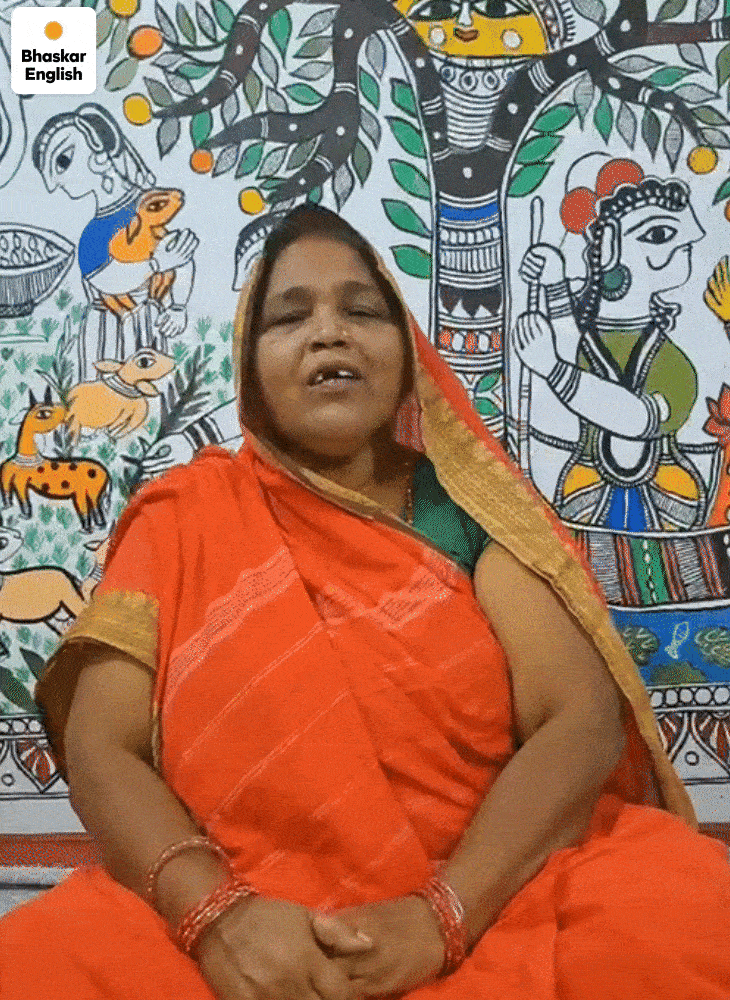Married at 12, husband abandoned her:Made first painting on hospital wall where her daughter died; broke down upon receiving Padma Shri
I am Dulari Devi. I am from village Ranti in Madhubani, Bihar. I have received the Padma Shri award in Madhubani painting. Currently, I am training 80 children at the Mithila Institute. I painted on the wall of the same hospital where my daughter took her last breath.
People ask, 'Dulari, how do you do all this?'
I just say, 'I turned pain into colours, otherwise I wouldn't have survived. In every painting, I make a child. That child is actually my daughter. This is how I keep her alive in colours.'
Once I went to Chennai. There I painted the story of my life. That painting came out as a book, for which I have been receiving royalty for 14 years.
Dulari Devi creating the world-famous Madhubani painting at her home. After her daughter's passing, she made painting her life.
Let me start from childhood. We had no connection with school, books or copies. Most of our lives were spent in poverty and hardship. We are from the Mallah community. We were four sisters, one brother and our parents. We used to work as labourers with our parents for two meals a day.
When I was young, I used to go fishing and collect makhana (fox nuts) in the pond with my father. Whether it was winter, rain, or summer, we had to go to the pond or river for work. When my brothers and sisters were very young, my father passed away. After that, our difficulties increased. My mother alone couldn't manage everything. Many times we had to go hungry.
When I turned 12, I was married off. At that time, I was just a child. There was a large family in my in-laws' house. Six sisters-in-law, one brother-in-law, and parents-in-law. There too, everyone had to work to run the household. I would go to sell fish and grass at my in-laws'. My husband had a very angry temperament. He would yell at me a lot. It was unbearable, but I endured everything considering my husband as god.
But when he would throw me out of the house at midnight, it felt terrible. My father-in-law would support him. At such times, I would stay at the neighbour's house. One day when they threw me out, I came back to my maternal home. By then, seven years of marriage had passed. After that, I never went back.
When I came to my maternal home, a daughter was born. There was a lot of happiness in the house when she was born. In a way, she became the biggest happiness of my life. She was named Shakuntala. Father-in-law had come to see the daughter, but my husband's behaviour hadn't changed at all. So I decided that I won't return to my in-laws' house now. I would spend the rest of my life with my daughter.
When my daughter grew a little older, mother started pressuring me for a second marriage, but I refused every time. I thought that nothing good came from the first marriage. I faced many hardships. What if the second one turned out the same way? This way, I never felt like marrying again.
Meanwhile, my daughter fell ill. We took her to the hospital. There we found out that she had typhoid. Doctors gave medicine, but her condition kept deteriorating. She died after a week. My daughter's body was lying in front of me. It felt like everything had fallen apart.
I thought that if a husband doesn't turn out good, a woman can live with the support of her child, but now my daughter had also left me. Later, I painted on the wall of the same hospital where my daughter died.
I was very worried after my daughter left. I was thinking about how I would spend my life now. Then I went to Karpuri Majhi's house in the village. He used to make Madhubani paintings. I started cooking and cleaning at his house. At that time, my grandfather also worked at his house.
Seeing my condition, one day Karpuri said, 'You should stay at my place.' My mother gave permission, then I started living there. Majhi had given me a bed and lantern to stay at his house. Paint and brush to pass the time. He used to give me 6 rupees and 4 rotis daily for working.
This way, while working at his house, I started learning painting. Majhi used to make very good paintings of Lord Ganesh. He would give me paper, paint and brush and say, 'Write your name on this and make flowers etc. Learn Madhubani painting, it is the art of our Mithila.'
After that, when Majhi and Chachi Dai would paint every day, I would stand near them and watch. I slowly started painting myself. I first started working on greeting cards. I used to get money for that. This way, while working with them, I started getting interested in painting.
Karpuri Majhi was very happy seeing my dedication. Some people had come to the village from the government to teach painting. Majhi got my name registered with them. It was the first day there. I was given a satin cloth for painting. It was very shiny and beautiful. I had never seen such a shiny cloth before that. Nervously, I refused to paint on it and returned back.
When Karpuri found out, he scolded me. He asked, 'How will this work?'
The next day he asked me to go again. When I went there, I was given cotton cloth. I drew a flower on it. Then I started learning to work on sarees. This way I would paint there and stay at Majhi's house. After that, I got lost in painting. Later an institute opened there and I worked in painting there for a total of 16 years.
During that time, Karpuri Majhi gave a lot of support. One day I was cooking food at home. He came and said, 'You are alone, how will you spend your life ahead? Get married.'
But I refused to marry again. I said, 'Now Madhubani painting is my worship. These colours are my life.'
Then he asked if I missed my daughter. I said, 'I do miss my daughter, but if I keep remembering her only, how will I make paintings?'
While doing all this, I stayed with Karpuri Majhi for 25 years and kept painting. I make a child in every painting. That is my daughter.
Actually, I love children very much. Whenever I see children's clothes anywhere while coming and going, I buy them. When someone's daughter is getting married, I miss my daughter Shakuntala a lot. These are all the reasons why there is always a small child in every painting of mine.
Dulari Devi making a painting. She learned painting in the village with help from Karpuri Majhi. After her daughter's passing, she cleaned utensils in people's homes. She made Madhubani painting her life.
Once we went to Chennai for a painting event organised by the Bihar government. There I was asked to paint my life story. I started working. In it, I showed how I used to do household chores. I used to plant rice, sell grass, and sell fish.
When four days passed, the organisers said to let it be. I told them that my story was not complete yet. Then I brought those thick papers to my home and painted the entire story one by one. Later that painting came in the form of a book. I have been receiving royalty on that book for 14 years.
Look at the walls of my house here. Madhubani paintings are made on these. In this painting, I have created boatmen, fish, fox nut, fox nut leaf, bamboo, and boats. When people come to meet me at my house, they also fill colours in it.
Actually, my life felt really empty. These colours filled that void. Colours are everything in the world. Life would become dry without colour.
In the end, I would say that there was a lot of sorrow in life. Got many setbacks, but overcame them. In 2021, I received the Padma Shri award. After that, I was honoured at Bihar Museum. I cried a lot that day. I was remembering every moment of struggle.
Currently I am teaching Mithila art and songs to children at Mithila Art Institute. There are 80 children here. I really enjoy being with these children. I hope that children will preserve this art form in the future as well.
Dulari is currently teaching Mithila art and songs to children at Mithila Art Institute. There are 80 children here. She hopes that children will preserve this art form in the future as well.
(Padma Shri awardee Dulari Devi shared these feelings with Bhaskar reporter Manisha Bhalla.)
Original Article via Bhaskar













